The first Italian modern protected cruisers:
Etna was the only survivor of a class of four protected cruisers dating from 1885-1888. Designed by Carlo Vigna and George Rendel, they were based on the Giovanni Bausan of 1883, herself largely based on a Sir W G Armstrong Mitchell & Co.’s Elswick design. Most importantly, they were built in Italian shipyards, gaining considerable knowledge in the process for this kind of ships (British exports of cruisers had been particularly successful). Ettore Fieramosca, was slightly longer than the others at 290 feet (88.4 m). For the others normal figures were 283 feet 6 inches between perpendiculars, 42 feet 6 inches in beam and 19 feet of draft. They had been armed originally two 254 mm guns, six 152 mm, five 57 mm, five 37 mm, 1 Revolver cannon, 2 machine guns and two to three torpedo tubes. Propellers were fed by two horizontal compound steam engines and four double-ended cylindrical boilers. They could reach on trials 17–17.8 knots (31.5–33.0 km/h; 19.6–20.5 mph).
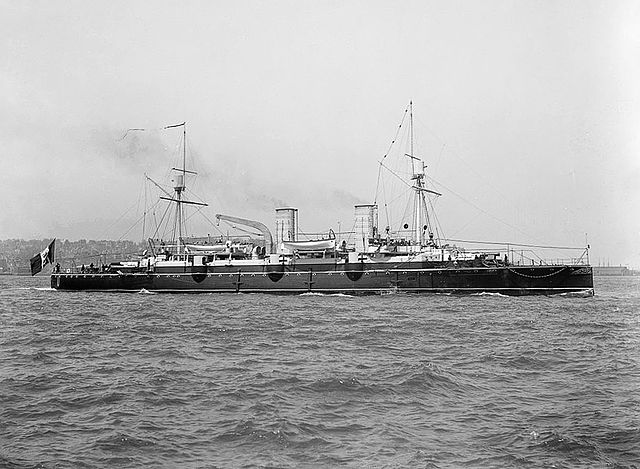
Giovanni Bausan (1883), a typical 1880s Elswick cruiser on which the Etna were based on.
The original Armstrong 10-inch (254 mm), 30-caliber breech-loading guns had been mounted in barbettes (open turrets) fore and aft, as customary for the 1880s. So despite their size, these ships packed quite a punch, being capable of delivering 450-pound (200 kg) shells flying at a muzzle velocity of 2,060 ft/s (630 m/s). Secondary armament was mounted in Vavasseur mountings, in sponsons. The secondary anti-torpedo armament was quite comfortable with 6-pounder Hotchkiss guns firing at 6 rpm, completed by 1-pounder Hotchkiss guns (37 mm) at 30 rpm. The general disposition of the torpedo tubes were one mounted underwater in the bow and the other three were above water, but for the Ettore Fieramosca which dispensed of a TT.

Cruiser Giovanni Bausan
The cruiser Giovanni Bausan
Protection was interesting as they had an armoured belt with a maximum thickness of 1.5 inches (38 mm) doubled with an inner belt of cork at their waterline to absorb water if needed.
Laid down in 1884 respectively at Castellammare, Venice and Livorno shipyards and completed in 1887 (Etna), 1888 (Vesuvio, Stromboli), and 1889 (Fieramosca). Part of the Squadra Permamente up to 1893, they visited South and North America several times. Etna was in Red Sea for the first Italo-Ethiopian War of 1895–6 and the Cretan Revolt of 1898. She became flagship of the Torpedo-Boat Command in 1904. The three other took part in the Boxer Rebellion, 8-Nation Alliance. Vesuvio was disarmed in 1911, so before the first Balkan war and Etna converted into a training vessel, acting as such from 1907 to 1914. She was assigned as a coast guard, was a floating HQ, a tanker and fleet HQ in Taranto, sold and BU in 1921.
Design

Ettore Fieramosca off Algiers
The Etna-class protected cruisers had a tailored design based on what Sir W G Armstrong Mitchell & Co.’s Elswick Works did for the earlier Giovanni Bausan. This was the first modern protected cruiser for the Italian Navy and proved successful enough to negotiate a licence to build copies, in Italian shipyards. George Rendel from UK and Carlo Vigna went at work on the design, with the first three ships varying in displacement and engine power. The last ship, Ettore Fieramosca, was slightly longer however.
As for the details, the initial project was created by the inspector engineer and general Carlo Vigna, on the Bausan as basis, with help of Rendel which spent time in Italy for this. This project however was for four “torpedo rams” (ariete torpediniere). The lead vessel was called Etna, the others Vesuvio, Stromboli and Ettore Fieramosca and their strange classification as torpedo boat still was there at the time of launch, but were reclassified as “protected cruisers, 2nd class” (incrociatori protetti di 2ª classe).
Hull and general design
The Etna-class were rather small cruisers at 283 feet 6 inches (86.4 m) long between perpendiculars. Their beam was generous at 42 feet 6 inches (13 m) giving them a 1:6.6 hull ratio. They had a mean draft of 19 feet (5.8 m) and displaced between ships from 3,373 and 3,474 long tons (3,427–3,530 t). Their crew amounted to 12 officers and 296 men. Ettore Fieramosca differed from the others by her overall length of 290 feet (88.4 m) between perpendiculars for a more generous beam of 43 feet 4 inches (13.2 m), so raised in the same proportion. Her draft was slightly lower at 18 feet 9 inches (5.7 m) for a displacement at 3,538 long tons (3,595 t) and a crew consisted of 17 officers and 298 men.
The general layout was conventional for the late 1880s, and very British export-esque, with a relatively low hull with counterkeels, a ram bow ending with a point, and a rounded stern, a wide beam for stability compensated by fine lines in entry and exit, a well-rounded hull by section. The two masts were mid-height, symmetrical like the remainder of the design, supporting each a combined fighting/spotting top. They carried everything needed for a potential rigging, shown in some early drawings, but never on photos. It was never installed. As usual for the time, the conning tower and the bridge above were located behind the main mast, somewhat impending visibility.
The wooden bridge supported a small open bridge for observation. They had two funnels, all straight like the masts. The whole central section, between barbettes for the main guns, had raised bulwarks, which were covered aft and forward to sipport light guns. The secondary guns were located on the broadside interleaved with the bulwarks behind large shields, with roofs and working as half-turrets. They had a collection of Dorade vents emerging from the central low structure embadding the funnel intakes, and collection of glassed wooden access hatches to lower decks. They also carried six main boats under davits along the sides and above the boats. They had a rear structure acting as steering bridge aft, in front of the aft mast.
As for their appearance, it was also typical of the time. The hull was painted in a dark red primer under the waterline, blak hue over it, and typically white structures and canvas yellow for the funnels, dorade vents, masts and funnels.
Powerplant
Propulsion relied on two reciprocating engines, each driven by a single fixed-pitch four-bladed bronze screw propeller. Steam came from four double-ended, coal-fired cylindrical boilers which developed 6,820 horsepower (5,020 kW) for a top speed of 17 knots (31 km/h), range of 3,500 knots (6,500 km/h). However figures were disputed. They had two horizontal compound steam engines and each drove a single propeller. The four double-ended cylindrical boilers were capable on sea trials to deliver between 6,252–7,480 indicated horsepower (4,662–5,578 kW) enabling the class to reached between 17–17.8 knots (31.5–33.0 km/h; 19.6–20.5 mph). For range, they carried between 575–620 long tons (584–630 t) of coal, enough for 5,000 nautical miles (9,300 km; 5,800 mi) at 10 knots (19 km/h; 12 mph).
Protection
As protected cruisers, they were fitted with a turtle-like armored deck below the waterline, typical of Vickers’s production. Maximum thickness was 1.5 inches (38 mm) on its slopes, lower for the flat central section (likely around 20 mm or 1 inch). But they had a structure built at waterline level, with a belt of cork-filled compartments, intended to seal holes by swelling through water absorption after a hit. These solutions, which predated the concept of self-sealing fuel tanks in aviation by decades, proved to be unsuccessful however. Hits would result in the destruction of the cork and it tended to deteriorate quickly.
The other protection was for the breech and loading area of the main guns, protected by an armored hood just 2 inches (51 mm) thick.
The secondary guns had shields only protected against bullets and lights shrapnels, as for the bulwark running along the battery deck.
The connng tower forward however was also made of compound armour, 13 mm or 0.5 inches thick.
Armament
The four sisters diverged again, the first three were armed the same with the following:
Two 254mm/30 B main guns, six 152mm/32 B, and four quintuple 57mm/40 Hotchkiss (6 pdr), five 37mm/20 Hotchkiss “corto” (short 3 pdr), a single 37mm/20 Hotchkiss corto, and two 11.4mm/94 Maxim machien guns, as well as two 350mm Torpedo tubes at the beam. Ettore Fieramosca diverged by her 152mm/40 Armstrong secondary guns, six single 57mm/40 or 6-pdr Hotchkiss guns and eight Hotchkiss 37mm/20 H corto, and the same.
Cannoni da 254mm/20
The Vickers-Armstrong 10-inches main gun were a common cruiser main gun of the time. They were placed in barbettes fore and aft with a small shielding aft of the barrel, acting as protection for the crew. There is no data one these.
Cannoni Armstrong da 152mm/33
These were 6-inch/32 guns Model 1887 in reality, made by the Elswick Ordnance Company and produced by Armstrong Whitworth specifically for the Regia Marina.
They were placed behind shields on either side on the broadside, whereas the whole battery deck was protected by tall bulwarks. Outside these cruisers, they were used by the Ruggiero di Lauria-class, Lepanto class and the Dogali.
Specs:
Mass 5.6 t (6.2 short tons)
Barrel length: 4.9 m (16 ft) 32.25 caliber
Shell: 45.3 kg (100 lb) Separate loading 8.8 kg (19 lb) bagged ballistite charge and projectile
Breech: Interrupted screw
Muzzle velocity: 605 m/s (1,980 ft/s)
57mm/40 Hotchkiss
The 6-pdr Hotchkiss had the following specs:
Mass: 821–849 lb (372–385 kg) barrel & breech
Length: 8.1 ft (2.5 m), barrel length 7.4 ft (2.3 m), 40 calibre
Shell: 57x307R; see ammunition section (2.244 in).
Breech: Vertical sliding-block with hydro-spring recoil 4 inch
The Rate of fire was 25 rounds a minute with a muzzle velocity of 1,818 feet per second (554 m/s)
The Effective firing range was 4,000 yards (3,700 m)
37mm/20 Hotchkiss “corto”
These are generic specs:
Mass: 240 kg (530 lb), 2 m (6 ft 7 in) overall, barrel 1.8 m (5 ft 11 in) for the 40 caliber.
Shell: Fixed QF 47 × 376 mm R full 3 kg (6.6 lb), head 1.5 kg (3.3 lb)
Breech: Vertical sliding-wedge.
Rate of fire: 30 rpm, muzzle velocity 571 m/s (1,870 ft/s), maximum range 5.9 km (3.7 mi) at +20°.
1900 Reconstruction
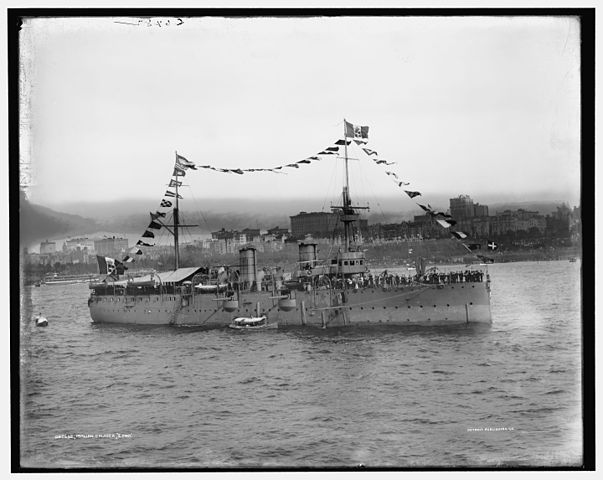
Etna as rebuilt, at the 1909 Hulton-Fulton Celebrations, Hudson bay, NYC
In 1900, they were rearmed with one 75 mm and 4 TTs, then in 1907-1909 (Not for the Stromboli and the Fieramosca, disarmed at these dates), their old 254 mm, two 152 mm were removed while two 120 mm guns were added. The remainder of her artillery were two 47 mm, two 37 mm and 2 TTs.
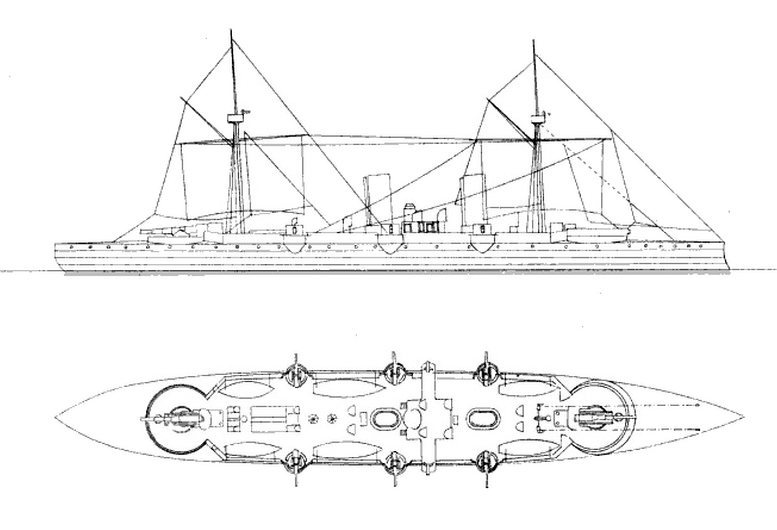
Line drawing of the Bausan. The Etna were very similar (after reconstruction)
Illustration of Etna as rebuilt in 1914
Etna class cruisers specs |
|
| Displacement | 3,390 long tons, 3,700 t FL |
| Dimensions | Length 91.4 m x 13.22 m x 5.8 m (283 x 42 x 19 ft) |
| Propulsion | 2 shafts, two DE engines, 4 boilers, 7200 hp, |
| Speed | 17 knots (31.5 km/h; 19.6 mph) |
| Range | 5,000 nautical miles (9,300 km; 5,800 mi) at 10 knots |
| Armament (Etna 1914) | 2x 152 mm, 2× 120 mm, 2x 47mm, 2x 37mm, 2 TT 350 mm. |
| Armor | Belt 38 mm, Barbettes 51 mm, Deck 30 mm, CT 13 mm |
| Crew | 321 |
Career
 Etna (1885)
Etna (1885)
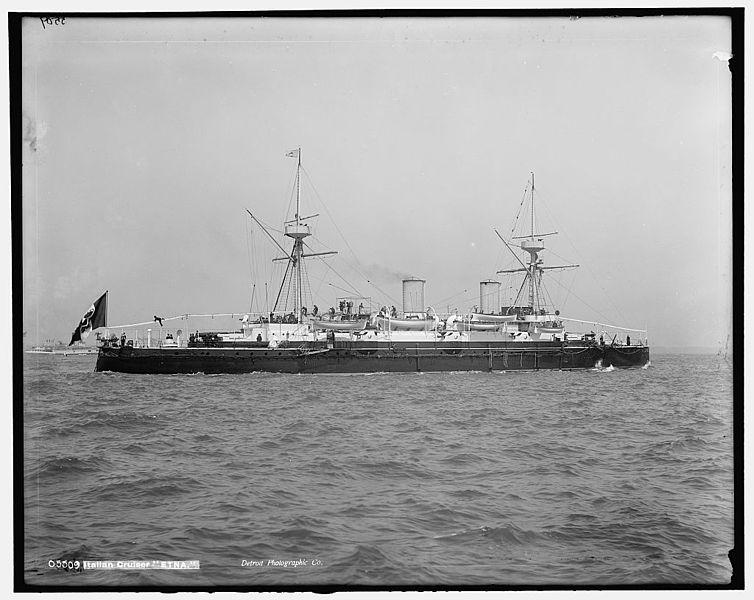
Italian cruiser Etna in its 1890s black, white and sand canvas livery
Etna was laid down at Castellammare di Stabia on 19 January 1884, launched on 26 September 1885 and completed on 2 December 1887. As a lead ship, she carried out large-scale maneuvers and training until 1893. Next, she was reassigned to the waters of North and South America until late 1895. She was stationed in the Red Sea in the First Italo-Abyssinian War of 1895-1896 and supported Italian interests during the Cretan revolt of 1897-1898. Next, she was transferred to the Far East and back in 1902. Disarmed as flagship of the High Torpedo Boat Command in 1904.
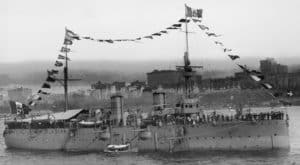
HD photo of the Etna on the Hudson Bay, 1909
She was sent to the shipyard for a full reconstruction and completely rebuilt between 1905 and 1907, with her superstructure enlarged, two 120 mm guns installed, one at the bow and one at the stern, plus four 6-inch guns, two per side. She served as a training ship after reconstruction, until the beginning of the First World War, and was used as headquarters in the port, later as a port defense, then depot and ended as the naval command headquarters in Taranto.
 Stromboli (1885)
Stromboli (1885)
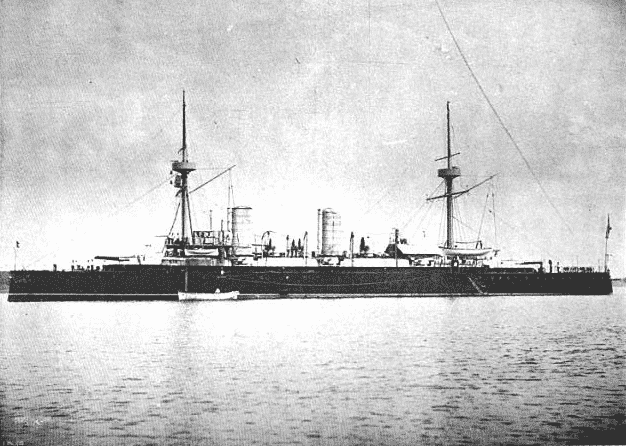
Italian protected cruiser Stromboli in 1895
Stromboli was laid down at Arsenale di Venezia on 31 august 1884, she wa slaunched on 4 febryary 1886 and completed on 20 march 1888. Stromboli, like her sisters Vesuvio and Ettore Fieramosca took part in the Naval Maneuvers of 1893. Stomboli and Ettore Fieramosca alone later took part in the Naval Maneuvers of 1896. Stromboli was sent to the Far East in 1899. In 1900 she was joined by Vesuvio and Ettore Fieramosca to take part in the Boxer Rebellion operations of the 8-Nation Alliance. After dowager Xixi relinquish her support for the Boxers, the Kingdom of Italy obtained a trade concession around the city of Tientsin. Stromboli returned to Italy in 1901 to be placed in reserve and act as an ammunition ship, before being decommissioned in 1907 and sold for scrapping in 1911.
 Vesuvio (1886)
Vesuvio (1886)
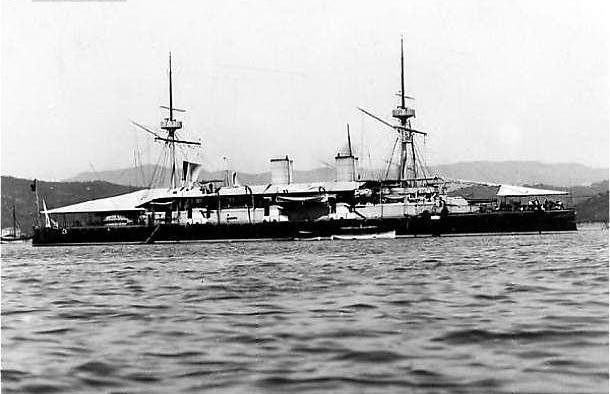
Vesuvio was laid down on 10 July 1883 at Orlando shipyard, Livorno. She was launched on 21 March 1886 and after the fitting-out work was completed, she entered service on 16 March 1888, and took part in the naval review for the visit to Italy of German Emperor Wilhelm II. After entering service, she took part in large-scale maneuvers and training. She took part in the naval maneuvers of 1893, and was placed in reserve in 1896, but reactivated, to take part in the year’s fall naval maneuvers. She was then assigned to a task force to defend the fleet from a simulated French fleet attack.
In February 1897, Vesuvio was sent to Crete to pressure the Ottomans during the Greek revolt altogether with the torpedo cruiser Euridice, pre-dreadnoughts Re Umberto, and Sicilia, which was the squadron’s flagship under Vice Admiral Canevaro. They were part of a multinational force with the Royal Navy, Austro-Hungarian Navy, French Navy, Imperial German Navy, and Imperial Russian Fleet. In 1900, both Vesuvio and Ettore Fieramosca were reassigned to the Far East, in order to support the international expedition’s landing in China, and for the suppression of the Boxer Rebellion, part of the 8-Nation Alliance. Later the Kingdom of Italy obtained a commercial concession in Tientsin. In 1901, Vesuvio made port calls to Shanghai, Wusong, and Hong Kong. After a second deployment to the Far East in 1906-1909, Vesuvio ended in reserve and was decommissioned on 11 May 1911, sold for scrap in 1915.
Name:
She was the second ship in the Regia Marina to bear the name of the volcano. The previous one was a second-rate paddle-wheel corvette built in Castellammare di Stabia, launched in 1824 (for the Bourbon Navy). The third was an AA cruiser ordered in 1938 by Thailand, built by Cantieri Riuniti dell’Adriatico in Trieste, launched in 1941 as Naresuan but requisitioned in 1942 and renamed, modified as a fast transport cruiser, but never completed. The fourth one was a logistics ship and merchant ship never completed, purchased by the new Marina Militare in 1948, transformed as a logistics ship. Today’s Vesuvio is a supply ship from 1979.
 Ettore Fieramosca (1888)
Ettore Fieramosca (1888)
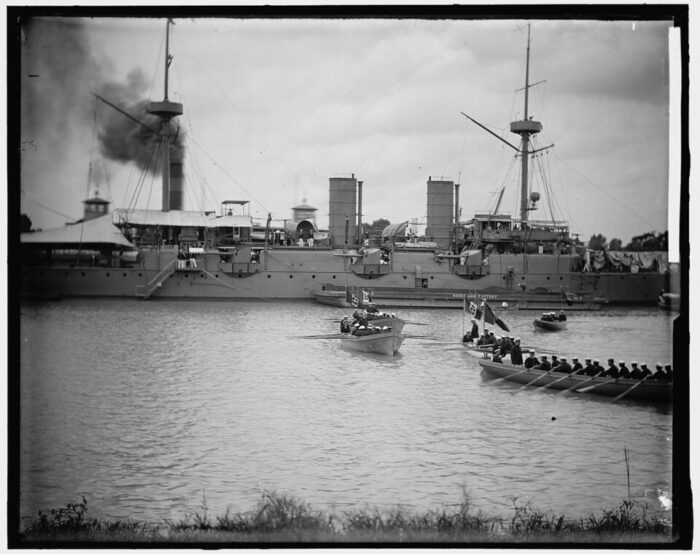
The last cruiser of the class was was laid down on 31 December 1885 at the Orlando shipyard in Livorno. During construction, she was lengthened by two metres and received a greater beam. She was launched on 30 August 1988, reclassified as a 2nd-tier armoured cruiser. Ettore Fieramosca was the second of the name. She was completed, and entered service on 16 November 1889, and initially, equipped with sails on two masts, quicklt removed. Her layout and armament were modified several times, with major refits in 1900 and 1907, with improvements in calibre, range and firing rate.
After entering service, she took part in large-scale manoeuvres and training, and test-launching torpedoes. On 1 August 1897, she received her battle flag in Naples, donated by Capua women, as the latter was the birthplace of Ettore Fieramosca. By the way, the latter was a famous 15000s Condotierre.
In 1899, Fieramosca was stationed in South America. From 1900 she was sent to the Far East, supporting the international landing forces and expedition in China, and the Boxer Rebellion. In 1905, she was assigned to the Oceanic Naval Division. She patrolled the coast of Africa and reached South America until 1908. She also visited Tierra del Fuego and the Strait of Magellan. In July 1908, she took part in Columbus Day, in Bridgeport, USA, taking part in an internatonal parade for the dicovery of the Americas by the Genoese navigator. She visited USS New Hampshire and there was friendly swap of crews. She was decommissioned on 15 July 1909 and sent to the demolition on 15 May 1911.
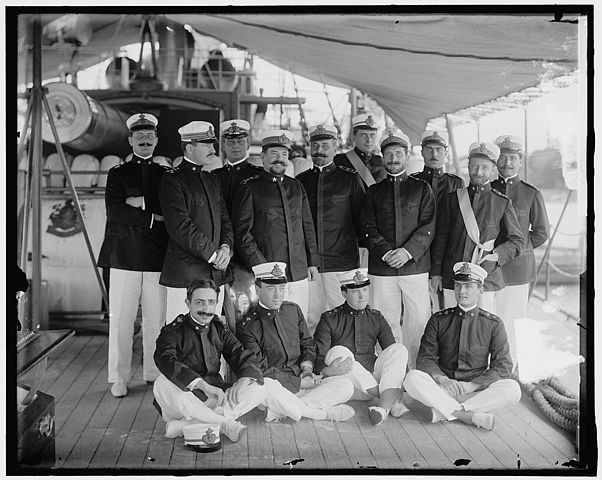
Ettore Fieramosca’s officers taking the pose
Links and More
Books
Specs Conway’s all the world fighting ships 1860-1905.
Note: Post scheduled for rewriting in 2026.
Links
https://navypedia.org/ships/italy/it_cr_etna87.htm
http://www.agenziabozzo.it/navi_da_guerra/C-Navi%20da%20Guerra/C-1050_RN_ETTORE_FIERAMOSCA_1888_incrociatore_fermo_nel_Golfo_della_Spezia_1897.htm
Etna class on Wikipedia
http://www.navweaps.com/Weapons/WNBR_Main.php
Model Kits
None

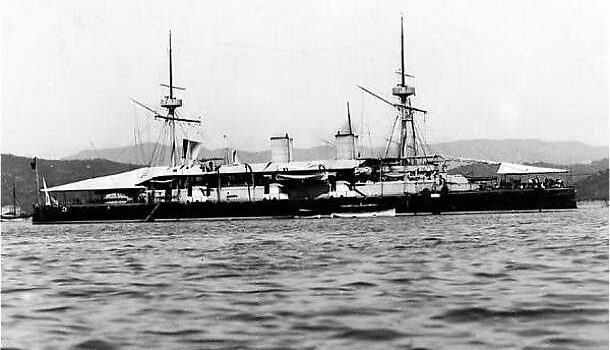

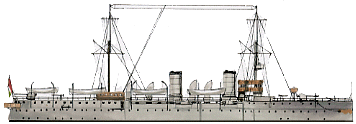
 Latest Facebook Entry -
Latest Facebook Entry -  X(Tweeter) Naval Encyclopedia's deck archive
X(Tweeter) Naval Encyclopedia's deck archive Instagram (@navalencyc)
Instagram (@navalencyc)





 French Navy
French Navy Royal Navy
Royal Navy Russian Navy
Russian Navy Armada Espanola
Armada Espanola Austrian Navy
Austrian Navy K.u.K. Kriegsmarine
K.u.K. Kriegsmarine Dansk Marine
Dansk Marine Nautiko Hellenon
Nautiko Hellenon Koninklije Marine 1870
Koninklije Marine 1870 Marinha do Brasil
Marinha do Brasil Osmanlı Donanması
Osmanlı Donanması Marina Do Peru
Marina Do Peru Marinha do Portugal
Marinha do Portugal Regia Marina 1870
Regia Marina 1870 Nihhon Kaigun 1870
Nihhon Kaigun 1870 Preußische Marine 1870
Preußische Marine 1870 Russkiy Flot 1870
Russkiy Flot 1870 Svenska marinen
Svenska marinen Søværnet
Søværnet Union Navy
Union Navy Confederate Navy
Confederate Navy Armada de Argentina
Armada de Argentina Imperial Chinese Navy
Imperial Chinese Navy Marinha do Portugal
Marinha do Portugal Mexico
Mexico Kaiserliche Marine
Kaiserliche Marine 1898 US Navy
1898 US Navy Sovietskiy Flot
Sovietskiy Flot Royal Canadian Navy
Royal Canadian Navy Royal Australian Navy
Royal Australian Navy RNZN Fleet
RNZN Fleet Chinese Navy 1937
Chinese Navy 1937 Kriegsmarine
Kriegsmarine Chilean Navy
Chilean Navy Danish Navy
Danish Navy Finnish Navy
Finnish Navy Hellenic Navy
Hellenic Navy Polish Navy
Polish Navy Romanian Navy
Romanian Navy Turkish Navy
Turkish Navy Royal Yugoslav Navy
Royal Yugoslav Navy Royal Thai Navy
Royal Thai Navy Minor Navies
Minor Navies Albania
Albania Austria
Austria Belgium
Belgium Columbia
Columbia Costa Rica
Costa Rica Cuba
Cuba Czechoslovakia
Czechoslovakia Dominican Republic
Dominican Republic Haiti
Haiti Hungary
Hungary Honduras
Honduras Estonia
Estonia Iceland
Iceland Eire
Eire Equador
Equador Iran
Iran Iraq
Iraq Latvia
Latvia Liberia
Liberia Lithuania
Lithuania Mandchukuo
Mandchukuo Morocco
Morocco Nicaragua
Nicaragua Persia
Persia San Salvador
San Salvador Sarawak
Sarawak Uruguay
Uruguay Venezuela
Venezuela Zanzibar
Zanzibar Warsaw Pact Navies
Warsaw Pact Navies Bulgaria
Bulgaria Hungary
Hungary

 Bundesmarine
Bundesmarine Dutch Navy
Dutch Navy Hellenic Navy
Hellenic Navy Marina Militare
Marina Militare Yugoslav Navy
Yugoslav Navy Chinese Navy
Chinese Navy Indian Navy
Indian Navy Indonesian Navy
Indonesian Navy JMSDF
JMSDF North Korean Navy
North Korean Navy Pakistani Navy
Pakistani Navy Philippines Navy
Philippines Navy ROKN
ROKN Rep. of Singapore Navy
Rep. of Singapore Navy Taiwanese Navy
Taiwanese Navy IDF Navy
IDF Navy Saudi Navy
Saudi Navy Royal New Zealand Navy
Royal New Zealand Navy Egyptian Navy
Egyptian Navy South African Navy
South African Navy






























 Ukrainian Navy
Ukrainian Navy dbodesign
dbodesign